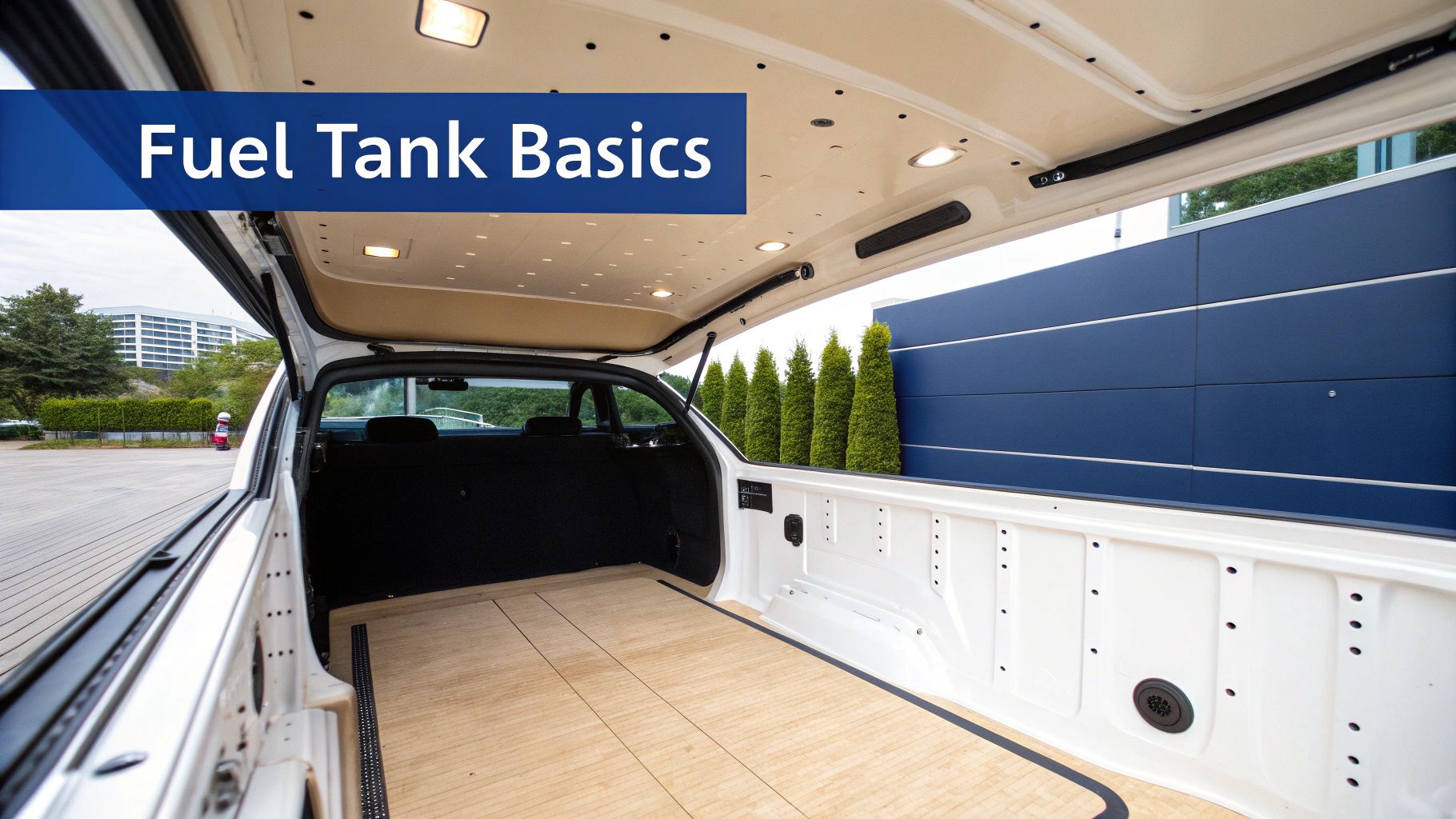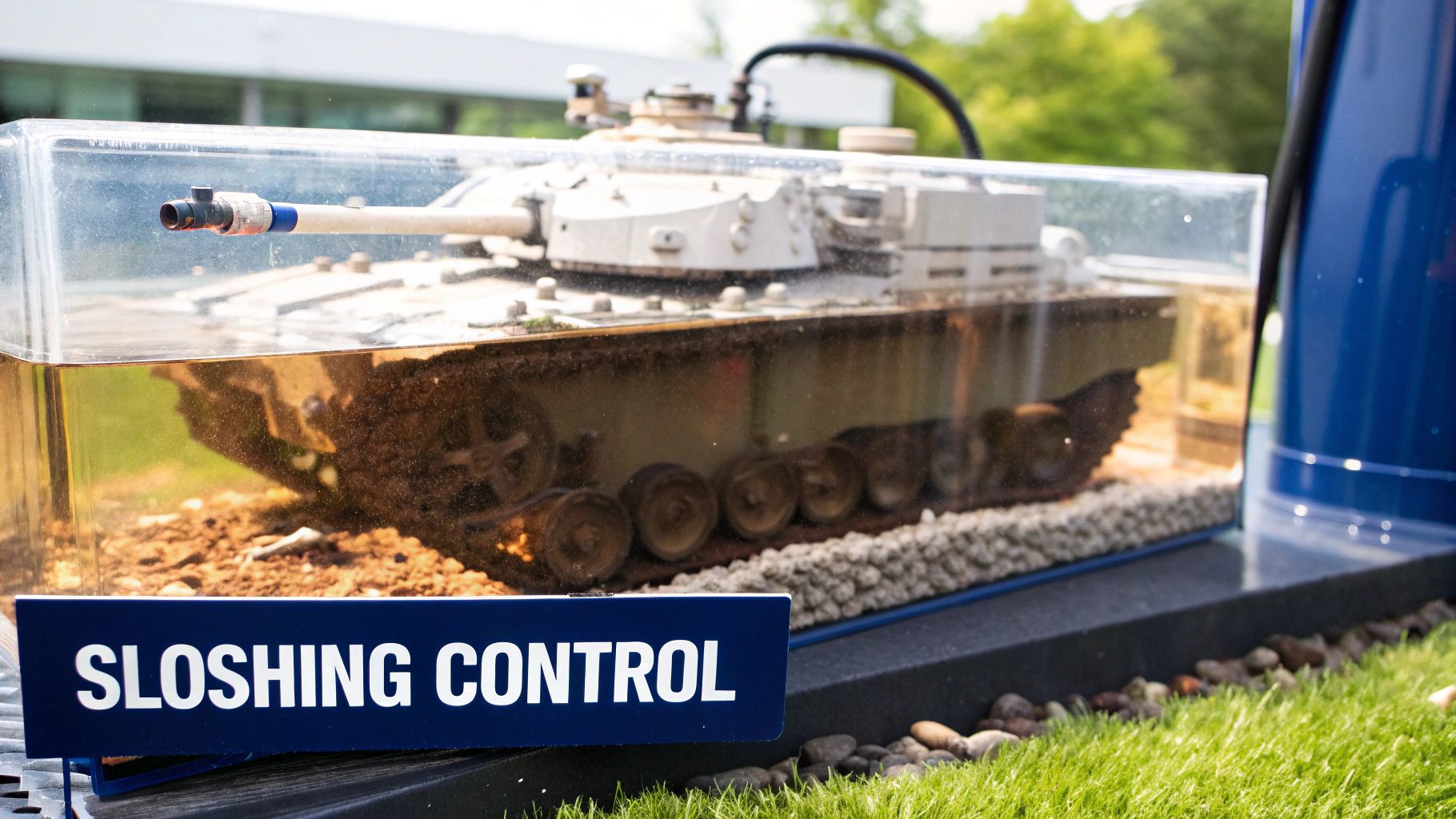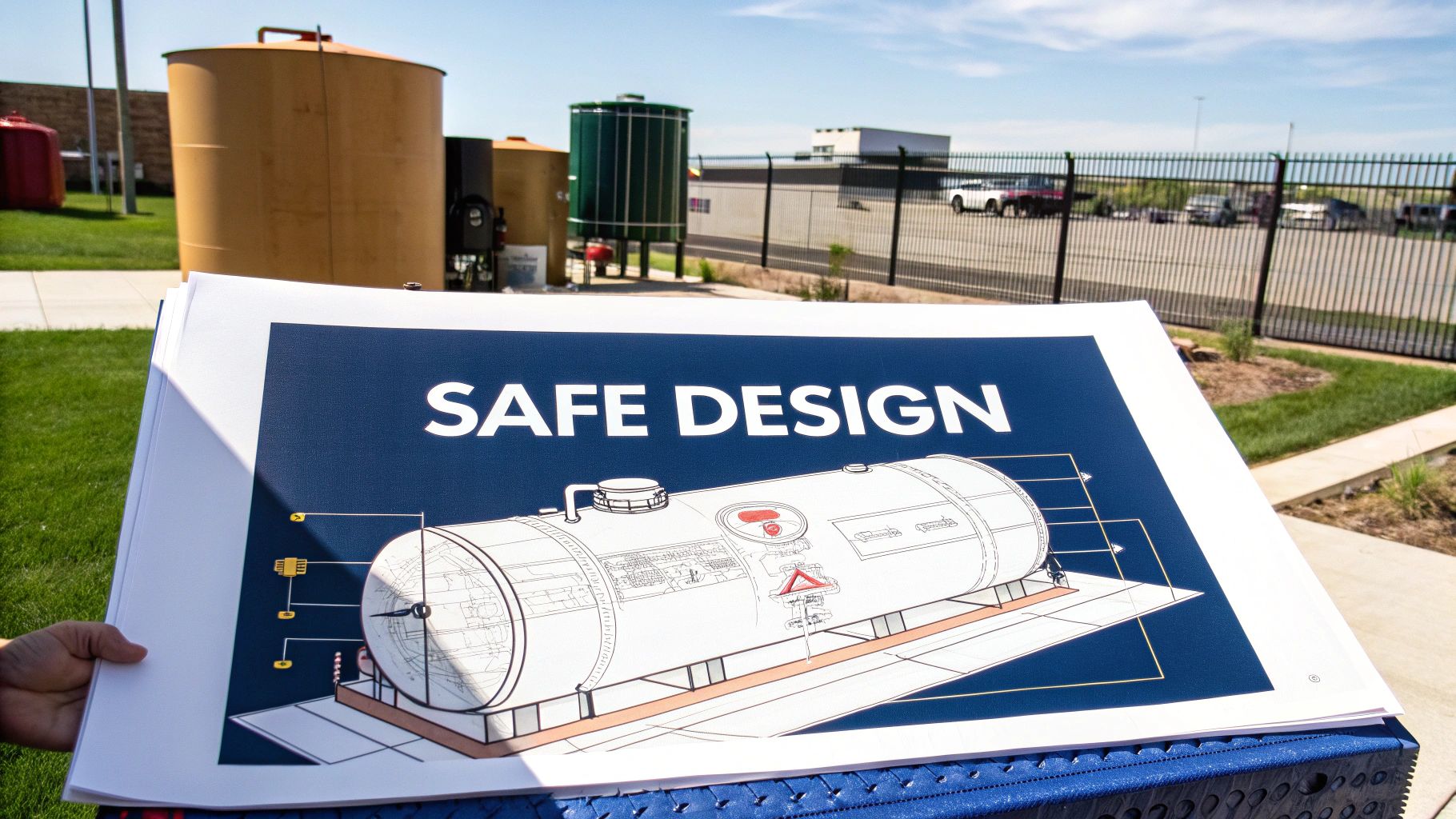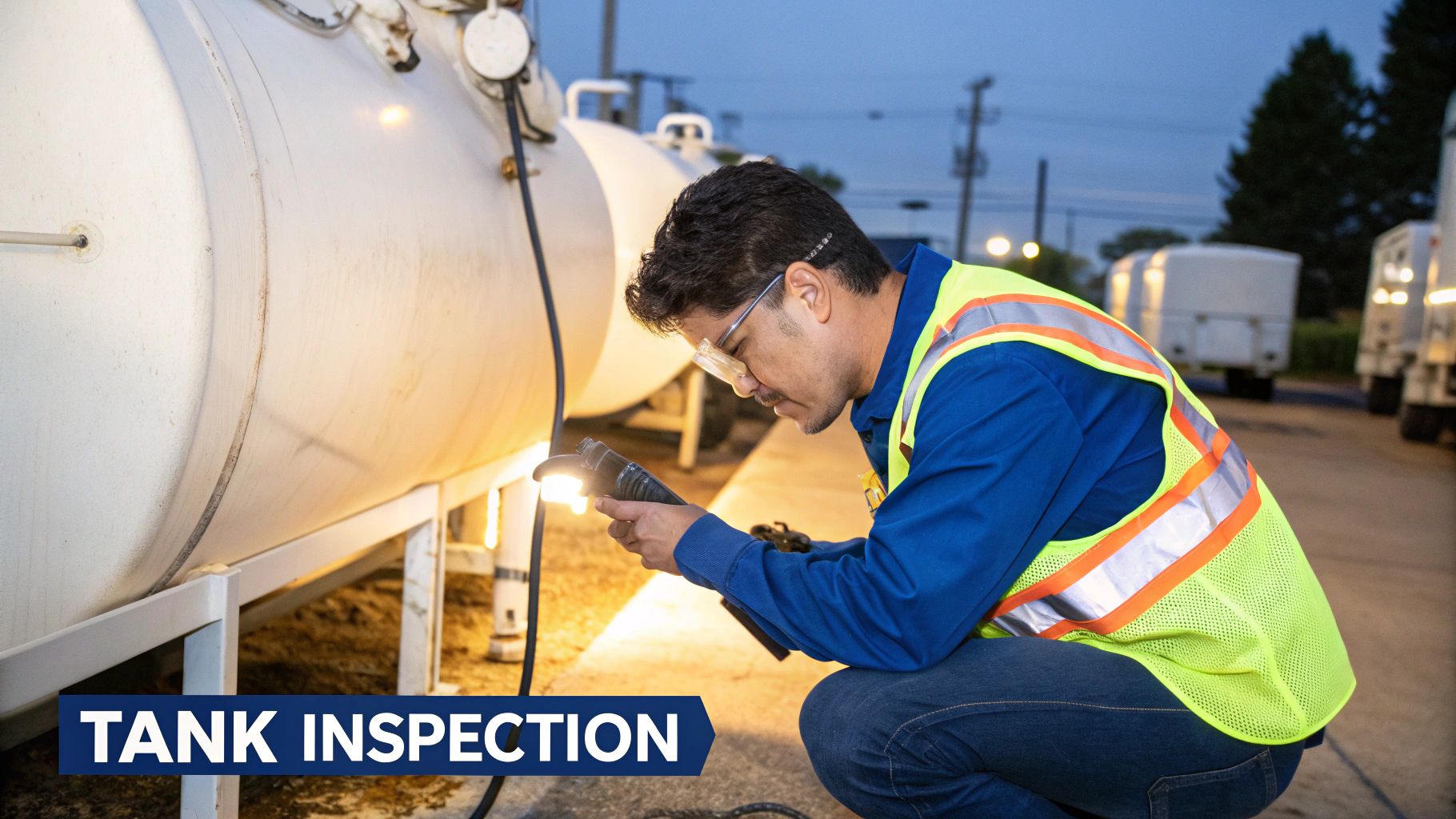The Hidden World of Baffle Fuel Tank Technology

A baffle fuel tank isn't just a container for fuel. It's a precisely engineered system designed to manage fuel movement within the tank. This is especially important during dynamic driving situations like hard cornering, rapid acceleration, and sudden braking.
Without baffles, fuel would slosh uncontrollably. This could starve the engine, leading to performance problems or even dangerous situations.
How Baffles Work: Preventing Fuel Starvation
Baffles are internal walls or dividers inside the fuel tank. They create compartments, restricting fuel movement during maneuvers. This ensures the fuel pump pickup has a consistent fuel supply, even when the tank is low or the vehicle experiences high G-forces.
Think of a partially filled water bottle. Shaking it causes the water to slosh wildly. A bottle with internal dividers would restrict that movement significantly. This is the core principle behind a baffle fuel tank.
Baffled fuel tanks are critical in high-performance vehicles and aircraft and have been around for decades. For example, some 1991 Pontiac Firebirds, a third-generation F-body, featured baffled fuel tanks. Discover more insights about baffled gas tanks here
These tanks prevent fuel starvation during aggressive driving, maintaining consistent fuel delivery. The baffles act as a small reservoir, keeping the fuel pickup submerged, even when the tank is low. This is vital for maintaining engine performance, especially in racing conditions where fuel sloshing can cause sputtering or stalling.
From Simple Dividers to Sophisticated Designs
Early baffle designs were often basic sheet metal dividers. Modern baffle systems, however, are complex structures optimized with Computational Fluid Dynamics (CFD). This allows engineers to fine-tune fuel flow patterns for maximum performance and minimum weight.
Materials science also plays a key role. Modern baffles often use advanced polymers and alloys for improved durability and corrosion resistance. This ensures the fuel system's longevity and reliability, even in extreme environments.
Baffles also improve vehicle safety. By controlling fuel slosh, they reduce the chance of fuel surges and leaks during accidents. This extra protection helps prevent fires and explosions, increasing occupant safety.
These developments showcase how seemingly minor design changes can have a significant impact on vehicle handling, safety, and performance. Baffle fuel tanks are an essential part of modern vehicles, from everyday cars to high-performance race cars.
Slosh Dynamics: The Science Driving Baffle Tank Design

Inside a fuel tank, seemingly simple metal dividers, known as baffles, play a vital role. These baffles manage the complex movement of liquid fuel, a field of study called slosh dynamics. Understanding slosh dynamics is essential for designing effective baffle fuel tanks.
This science explores how liquids behave inside a container under different conditions, like acceleration, braking, and cornering. Proper baffle design ensures efficient fuel delivery and overall vehicle performance.
Transforming Chaotic Movement into Controlled Flow
Without baffles, fuel would slosh uncontrollably within the tank. Sudden movements like braking or turning would cause the fuel to surge, potentially uncovering the fuel pump pickup. This can lead to fuel starvation and a subsequent loss of engine power.
Baffles strategically interrupt this chaotic sloshing. They redirect the fuel, creating more predictable and controlled flow patterns. This ensures a consistent fuel supply to the engine, even during aggressive maneuvers.
For example, during hard cornering, baffles prevent fuel from accumulating on one side of the tank. This maintains a steady fuel flow to the engine, crucial for high-performance vehicles and in motorsport where consistent power is paramount. You might be interested in: CLiX Fueling Solutions Sitemap
The Impact of Baffle Design on Fuel Delivery
Extensive research demonstrates the effectiveness of baffles in controlling fuel slosh. Different baffle designs offer varying levels of control over fuel movement. Studies have shown that specific designs can significantly reduce the forces and moments created by sloshing in partially filled tanks.
For instance, semi-circular orifice baffles have proven to be more effective than traditional baffle designs, especially when the tank is more than 50% full. Explore this topic further This improved control enhances vehicle stability and safety, particularly when transporting large fluid volumes.
Even seemingly small adjustments to a baffle's shape, size, and position can dramatically impact fuel delivery reliability. The number and configuration of baffles are carefully engineered to match the tank's geometry and the vehicle's intended use.
Computational Modeling: Revolutionizing Baffle Configuration
Computational Fluid Dynamics (CFD) has revolutionized modern baffle design. CFD software allows engineers to simulate fuel movement within the tank under various operating conditions.
This technology offers several key advantages:
-
Analyzing G-Forces: CFD predicts fuel behavior during acceleration, braking, and cornering. This allows for optimized baffle placement to minimize sloshing.
-
Optimizing Tank Geometry: Tank shape also affects slosh dynamics. CFD helps engineers design tank geometries that complement the baffle system for maximum efficiency.
Using CFD, engineers fine-tune baffle configurations for specific applications, ensuring consistent fuel delivery even under extreme conditions. This precision is vital in demanding environments like motorsport, where even a brief interruption in power can have significant consequences. CFD also contributes to improved fuel efficiency, reduced emissions, and enhanced safety by minimizing fuel sloshing and optimizing fuel delivery.
The following table provides a comparison of various baffle designs:
Baffle Design Comparison for Slosh Control This table compares different baffle designs and their effectiveness in controlling fuel movement under various conditions.
| Baffle Type | Slosh Reduction % | Weight Impact | Manufacturing Complexity | Best Applications |
|---|---|---|---|---|
| Flat | Up to 30% | Low | Simple | General purpose tanks |
| Vee | Up to 40% | Moderate | Moderate | Automotive fuel tanks |
| Ring | Up to 50% | Moderate | Moderate | Large storage tanks |
| Semi-circular orifice | Up to 60% | Moderate | Complex | High-performance vehicles |
| Perforated | Up to 45% | Low | Moderate | Aerospace applications |
As this table shows, different baffle types offer varying degrees of slosh reduction, impacting weight, manufacturing complexity, and suitability for different applications. Choosing the right baffle design is crucial for optimizing fuel system performance and safety.
Building Better Baffle Fuel Tanks: Materials That Matter

A baffle fuel tank's effectiveness isn't just about design; it's also about the materials used. The right materials impact the tank's durability, weight, and resistance to corrosion. Knowing the properties of various materials is key to building a high-performing, long-lasting tank.
Exploring Material Options for Baffle Fuel Tanks
Several materials are common choices for baffle fuel tanks, each with pros and cons. Aluminum alloys are popular for their light weight and strength. However, they can corrode, especially in marine environments. High-Density Polyethylene (HDPE) offers excellent corrosion resistance and is a good choice when chemical compatibility is important. However, HDPE might not be as strong as some metal options.
Fuel tank construction, including baffled tanks, requires careful design and fabrication for safety and efficiency. Common materials include HDPE or metal. Weight and stress resistance are also important factors. In aircraft and racecars, baffles often have lightening holes to minimize weight without sacrificing strength. Baffles prevent fuel starvation and ensure consistent engine performance. Learn more about fuel tanks.
The Role of Fabrication Techniques
Fabrication techniques significantly impact a baffle fuel tank's performance. Welding is critical for metal tanks. A poor weld can compromise the tank, causing leaks. TIG welding is often preferred for aluminum tanks due to its precision and ability to create strong, clean welds. Proper sealing is also essential to prevent leaks and ensure long-term durability.
For plastic tanks, rotational molding or blow molding are common. These methods create seamless tanks with consistent wall thickness for added strength and fewer leaks. The choice of technique often depends on the tank's size, complexity, and material.
Balancing Competing Priorities: Strength, Weight, and Corrosion
Building a better baffle fuel tank is about balancing competing needs. Strength is vital to withstand fuel slosh and impacts, but excess weight hinders vehicle performance. Corrosion resistance is crucial for longevity, especially in harsh environments.
Professional builders consider these factors when selecting materials and fabrication techniques. In race cars, lightweight aluminum alloys and optimized baffle designs are often used to minimize weight. For boats, where corrosion resistance is paramount, HDPE or other corrosion-resistant materials are preferred.
Understanding the specific needs of the application is key. By balancing strength, weight, and corrosion resistance, builders can create baffle fuel tanks that perform well and last. This might involve specialized coatings or advanced manufacturing like 3D printing for complex baffle designs.
Extreme Performance: When Baffle Fuel Tanks Save the Day

Properly designed baffle fuel tanks are crucial for maintaining peak performance in high-pressure situations. They're the unsung heroes ensuring consistent fuel delivery when it matters most. This is particularly true in motorsports, where a momentary loss of power can be the difference between winning and losing.
Rally Racing: Conquering Brutal Terrain
Rally cars face incredibly punishing conditions. They navigate rough terrain, endure jarring jumps, and take tight corners at breakneck speeds. These extreme maneuvers put intense forces on the fuel inside the tank.
Without a baffle fuel tank, fuel would slosh around uncontrollably, starving the engine at critical points. Baffles ensure the fuel pump pickup stays submerged, providing a constant fuel supply no matter the terrain. This lets rally drivers push their vehicles to the absolute limit. For these teams, robust baffle systems aren't just an upgrade—they're a necessity.
Drifting: Maintaining Power Under Lateral G-Forces
Drifting involves intentional oversteering, making the car slide sideways. This controlled loss of traction creates significant lateral g-forces, pushing fuel to one side of the tank.
Special baffle configurations within drift cars’ fuel tanks ensure consistent fuel flow to the engine, even under these extreme lateral forces. This lets drivers maintain power and control during drifts, executing precise maneuvers.
Aviation: Non-Negotiable Safety in the Skies
In aviation, proper baffle design is paramount. Fuel starvation mid-flight can be disastrous. Baffles in aircraft fuel tanks guarantee a continuous fuel supply to the engine, even during complex maneuvers or turbulence. For aviation experts, consistent fuel delivery is non-negotiable for safe, reliable flight.
Interestingly, the design and performance of baffled fuel tanks is discussed even within the model aircraft community. The need for precise engineering in fuel tank design is clear across many applications.
The Real-World Consequences of Fuel Starvation
Fuel starvation can have serious consequences:
- Engine sputtering: This leads to power and control loss, hindering speed and maneuvers.
- Engine stalling: Complete power loss is dangerous, especially during critical actions or at high speeds.
- Vehicle damage: Fuel starvation can damage the fuel pump or other engine parts.
Ensuring Consistent Performance
Across many disciplines, top performers recognize the vital role of a reliable fuel system. They depend on baffle fuel tanks to:
- Maintain consistent fuel delivery: This lets drivers and pilots concentrate on performance, not worrying about fuel issues.
- Enhance vehicle stability: Controlling fuel slosh improves handling and predictability.
- Increase safety: Baffles minimize fuel surges and leaks, protecting the vehicle and its occupants.
Investing in high-quality baffle fuel tanks ensures consistent performance under pressure, whether it's winning a race or landing safely. This commitment to fuel system reliability highlights the critical role of baffle tanks in achieving optimal performance and safety.
Baffle Fuel Tanks: The Unsung Heroes of Vehicle Safety
Baffle fuel tanks are essential for vehicle safety, working diligently behind the scenes to prevent accidents and protect passengers. While car enthusiasts often focus on horsepower and handling, the safety these tanks provide is just as important. They represent a carefully engineered balance between managing fuel, maintaining tank structure, and ensuring predictable vehicle handling in critical moments.
Preventing Dangerous Fuel Surges
One of the key safety features of baffle fuel tanks is their ability to prevent dangerous fuel surges during emergency maneuvers. Imagine having to swerve suddenly to avoid an obstacle. Without baffles, the fuel inside the tank would slosh violently. This sudden shift in fuel mass could destabilize your vehicle, making it harder to control. Baffles restrict fuel movement, helping maintain vehicle stability. This means your car is more likely to respond predictably in a critical situation, potentially preventing an accident.
Maintaining Engine Power During Emergencies
Baffle fuel tanks also help keep your engine running when you need it most by preventing fuel starvation. If the fuel pump pickup becomes uncovered during a sudden maneuver, the engine could stall. This could lead to a loss of power steering and braking assistance, drastically reducing your control. Baffles ensure a consistent fuel supply to the engine, helping you maintain control in these emergency situations. This consistent supply could be the difference between safely avoiding a collision and losing control of your vehicle.
Addressing Regulatory Focus on Fuel System Stability
Fuel tank safety and design have long been critical areas of research, particularly concerning impact resistance. For instance, in 2013, the Federal Railroad Administration conducted impact tests on locomotive fuel tanks at speeds between 4.5 and 6.2 mph. The tests showed localized buckling of the tank structure and baffles, but no catastrophic damage to the baffles themselves. This reinforces the importance of baffles in maintaining tank integrity during impacts. Discover more insights about fuel tank safety. You can also explore: CLiX Fueling's Sitemap.
Safety regulators are increasingly focusing on fuel system stability during impacts, and baffle technology directly addresses these concerns. Baffles not only help prevent fuel spillage during an accident but also contribute to the overall structural integrity of the tank. A robust fuel tank is less likely to rupture in a crash, minimizing the risk of fire and explosions.
Balancing Safety, Performance, and Integrity
Designing a baffle fuel tank is a complex balancing act. Engineers must consider several factors:
- Baffle Configuration: The number, size, and placement of baffles directly impact fuel control and tank strength.
- Material Selection: The tank material needs to be strong enough to withstand impacts and resistant to corrosion.
- Manufacturing Techniques: Proper welding and sealing are essential for preventing leaks and ensuring long-term durability.
Each of these factors contributes to the overall safety and performance of the baffle fuel tank. The ultimate goal is to create a system that efficiently manages fuel movement, maintains structural integrity in the event of a collision, and ensures predictable vehicle handling during emergencies. This careful balance of safety, performance, and integrity is what makes baffle fuel tanks the unsung heroes of vehicle safety.
Selecting Your Ideal Baffle Fuel Tank Solution
Finding the right baffle fuel tank requires careful consideration. Whether you're driving daily or hitting the racetrack, understanding your needs is key to making the right choice. This guide breaks down the essentials of baffle fuel tank selection.
Assessing Your Driving Demands
First, think about your typical driving situations. A daily commute has very different fuel demands than a weekend at the track. Consider these important factors:
- Driving Style: Aggressive driving with lots of acceleration, braking, and cornering needs a stronger baffle system than regular city driving.
- Vehicle Type: Your vehicle's weight, center of gravity, and purpose (racing, off-roading, etc.) impact baffle design needs.
- Fuel Capacity: Larger tanks need more complex baffles to manage fuel movement.
Matching Baffle Configuration to Your Needs
Different baffle configurations offer varying levels of fuel control. Here are some common types:
- Flat baffles: Good for general use and basic slosh control.
- Vee baffles: Often found in standard cars, these improve control during cornering and braking.
- Ring baffles: Used in larger tanks to reduce radial sloshing.
- Semi-circular orifice baffles: The best choice for high-performance driving, offering superior control under high g-forces.
Understanding these configurations lets you match the right baffle type to your driving style and needs, optimizing performance and safety.
Material Selection and Mounting Considerations
The material of your fuel tank matters for durability and performance. Aluminum is popular because it's lightweight, while HDPE is great for corrosion resistance. The right choice depends on your driving environment and how you use your vehicle.
Secure mounting is just as important. Solid mounting prevents cracks and keeps the tank stable. The mounting method should also handle thermal expansion and vibration to prevent leaks.
Custom vs. Off-the-Shelf Solutions
You can choose a custom-built tank or an off-the-shelf model depending on your needs and budget.
- Custom tanks: Offer more design flexibility, letting you choose specific baffles and materials. These are usually more expensive.
- Off-the-Shelf tanks: A cost-effective choice for common uses, readily available in many sizes and configurations.
An off-the-shelf tank often works well for standard needs. But for specialized applications or unique performance goals, a custom-built tank is the best solution.
Making Informed Decisions: Asking the Right Questions
When choosing a baffle fuel tank, don't hesitate to ask these important questions:
- What baffle configuration is best for my vehicle and driving style?
- What material will hold up best in my driving conditions?
- How will the tank be mounted, and will it handle temperature changes?
- What's the warranty and expected lifespan of the tank?
Asking these questions and knowing what you need will help you find the perfect baffle fuel tank for performance and safety. This ensures you invest wisely in a system that meets your exact requirements.
To help you choose the right tank, take a look at the table below:
Baffle Fuel Tank Selection Guide by Application This table helps readers identify the ideal baffle fuel tank configuration based on their specific vehicle type and usage patterns
| Application Type | Recommended Baffle Configuration | Material Preference | Key Features to Look For | Typical Cost Range |
|---|---|---|---|---|
| Daily Driver | Flat or Vee baffles | HDPE or Aluminum | Corrosion resistance, leak-proof design | $300 - $800 |
| High-Performance Street Car | Semi-circular orifice or Vee baffles | Aluminum | Lightweight, high g-force resistance | $800 - $1500 |
| Racing (Track/Off-Road) | Custom configuration | Aluminum or Composite | Maximum slosh control, lightweight | $1500+ |
| Marine | Flat or Vee baffles | HDPE | Corrosion resistance, impact resistance | $400 - $1000 |
This table offers a general guide. Talking with a trusted manufacturer will help you select the best baffle fuel tank for your needs and budget.
The Future of Baffle Fuel Tank Innovation
The baffle fuel tank, a vital component in many vehicles, is constantly evolving. New technologies and engineering methods are pushing the limits of baffle design and performance. This progress is driven by advancements in Computational Fluid Dynamics (CFD), innovative manufacturing techniques, and the integration of smart sensor technology.
Computational Fluid Dynamics: Shaping the Future of Baffle Design
Computational Fluid Dynamics (CFD) plays a crucial role in optimizing baffle fuel tank design. This powerful tool allows engineers to simulate fuel slosh inside the tank under different driving conditions like acceleration, braking, and turning. By understanding how fuel moves within the tank, engineers can design effective baffle geometries.
These designs maximize fuel control and minimize weight, which are essential for vehicle performance and fuel efficiency. CFD helps fine-tune the size, shape, and placement of baffles, leading to improved fuel management. This precision is especially important in high-performance vehicles where even small improvements in fuel delivery can make a big difference.
Advanced Manufacturing: 3D Printing and Beyond
3D printing is revolutionizing baffle fuel tank manufacturing. This technology allows for the creation of complex internal structures that were previously impossible to make with traditional methods. Intricate baffle designs, optimized through CFD, can now be manufactured with greater precision and efficiency. 3D printing also enables rapid prototyping so engineers can quickly test and refine new designs.
Imagine a baffle system with micro-structures engineered to precisely control fuel flow. This level of detail is now possible thanks to 3D printing. Beyond 3D printing, other advanced manufacturing techniques like laser welding and robotic assembly are also improving baffle tank construction.
Smart Tanks: Integrating Sensor Technology
The future of baffle fuel tanks includes embedded sensor technology. These sensors provide real-time data on fuel levels, temperature, and pressure. This data helps optimize fuel delivery, monitor tank health, and even predict potential problems.
For example, sensors can detect unusual fuel slosh patterns which might indicate an issue with the baffle system. This allows for preventative maintenance, reducing the risk of expensive repairs and downtime. Learn more in this article about blog posts on fuel tank solutions.
Addressing the Challenges of Alternative Fuels
As the automotive industry shifts towards alternative fuels and hybrid systems, baffle fuel tank design must also adapt. Different fuels have different properties that impact how they behave inside the tank. Baffle designs optimized for gasoline may not be effective for alternative fuels.
This presents new challenges for engineers, requiring innovative baffle designs and materials. CFD and advanced manufacturing are essential for developing baffle systems that can handle various fuel types.
These baffle fuel tank innovations aren't just about improving performance; they're also about enhancing safety. By controlling fuel movement, these advanced systems reduce the risk of fuel spills, leaks, and surges. The baffle fuel tank will continue to evolve, becoming even more sophisticated and crucial for vehicle performance and safety.
Looking for a safe and reliable fueling solution for your boat? Check out CLiX Fueling Solutions at https://clixfueling.com. This innovative product provides a stress-free, spill-free fueling experience, preventing overfills and protecting your boat and the environment.











